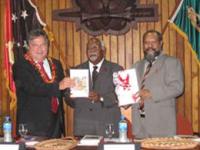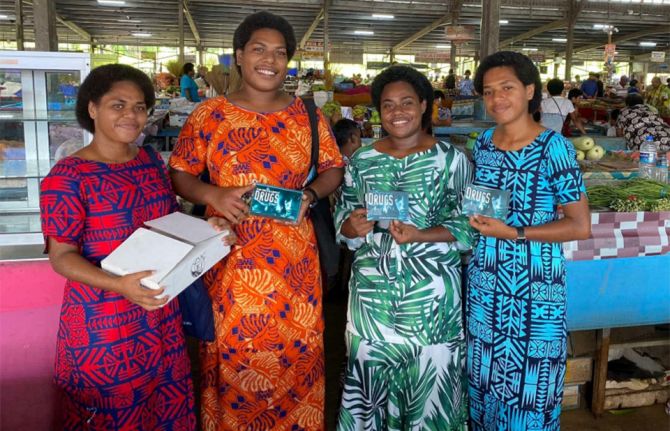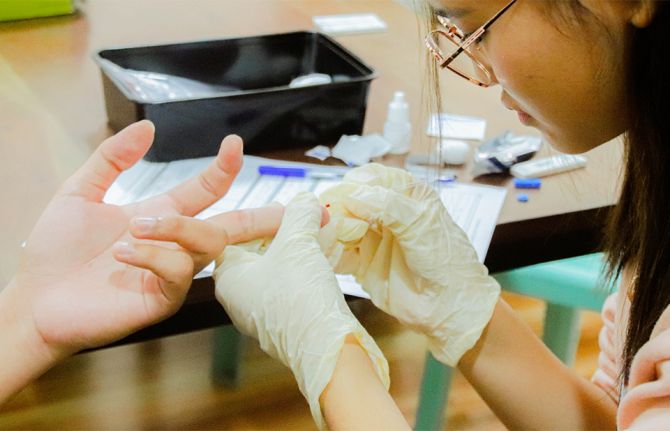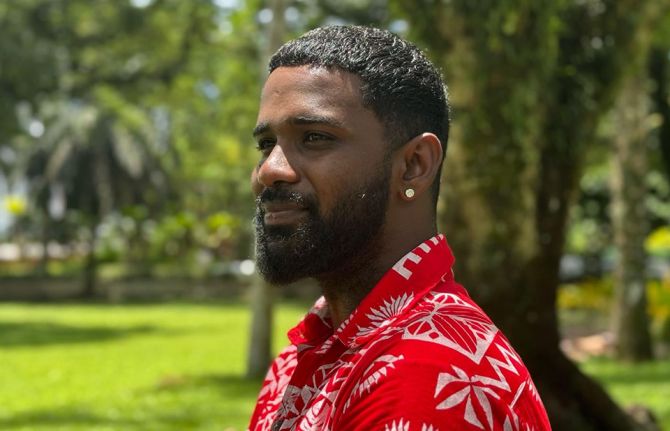
Feature Story
Papua New Guinea launch of the Commission on AIDS in the Pacific
11 March 2010
11 March 2010 11 March 2010
(L to R) Hon Sasa Zibe, PNG Minister of Health and HIV/AIDS, Governor General Sir Paulius Matane and Hon Misa Telefoni, Chairperson of the Pacific AIDS Commission and Deputy Prime Minister of Samoa during the simultaneous launch of the Pacific AIDS Commission Report and the National HIV Prevention Strategy 2010-2015. PNG, 11 March 2010.
The first Pacific launch of the report “Turning the Tide: An OPEN strategy for a response to AIDS in the Pacific” took place in Papua New Guinea on Thursday 11 March 2010. The report is the first document to synthesize regional and country information on epidemiology, risks and vulnerabilities, and financing and coordination of the AIDS response. Issues of rights and civil society as well as the impact of AIDS on health are also highlighted.
The report was officially launched by the UN Secretary-General in New York on 2 December 2009. It was produced by the Commission on AIDS in the Pacific, an independent body established to provide an objective and independent analysis of the status and impact of the HIV epidemic in the Pacific region.
“UNAIDS fully supports this report and finds that many of the recommendations in the report align very closely with the priorities identified in the Outcome Framework for Action agreed by all the 10 cosponsors and the secretariat of UNAIDS” said Mr Sidibé.
According to the report, a number of factors have hindered the region’s response to the epidemic. Limited awareness and understanding of the potential impact of the epidemic, weak health care systems and an unsupportive legal environment have all contributed to varying degrees of success by Governments across the region. The report has clearly highlighted the factors inhibiting a strong and determined response to the epidemic. While some of these are known, it is for the first time that all the issues were addressed by the Commission.
His Excellency Sir Paulias Matane, Governor General of Papua New Guinea officiated the national launch of the report together with Honourable Deputy Prime Minister of Samoa and the Chair of the Commission on AIDS in Pacific. J.V.R. Prasada Rao, Special Advisor to the UNAIDS Executive Director delivered a speech on behalf of UNAIDS Executive Director Michel Sidibé.
Uneven response in the region
Pacific countries are often included in broad Asia-Pacific regional groupings where the magnitude of the problem in Asian countries overshadows the challenges and needs of smaller Pacific countries.
These realities about the regions led to the constitution of an independent Commission on AIDS in the Pacific in October 2007 to examine the current scale of the HIV epidemic in the region.
There have been 29,629 reported cases of people living with HIV in the Pacific, with 5,162 new HIV diagnoses reported in 2008.
Papua New Guinea makes up the largest share of cases, growing exponentially from 21% in 1984–1989 to over 99% in 2008. Reported cases in Papua New Guinea total 28,294 but UNAIDS estimates there are 54,000 people living with HIV. It is estimated that by 2012, Papua New Guinea will have a national prevalence rate of 5.07% and a total of 208,714 people will have been infected with HIV.
The predominant means of HIV transmission in the region is unprotected sex. The number of HIV-positive young people is steadily increasing and young women are infected earlier than young men. New Caledonia, French Polynesia and Guam have identified unprotected male-to-male sex and injecting drug use as key issues to address to effectively respond to the epidemic.
The report states that a “one size fits all” response does not suit the diversity of Pacific nations and outdated legislation criminalizing homosexuality and sex work is a major impediment in the region.
Papua New Guinea launch of the Commission on AIDS
Speeches:
Speech by UNAIDS Executive Director Michel Sidibé delivered by J.V.R. Prasada Rao, Special Advisor to the Executive Director (11 March 2010)
Publications:
Turning the Tide: An OPEN strategy for a response to AIDS in the Pacific (pdf, 1.52 Mb.)



